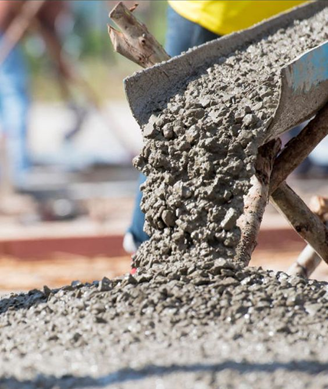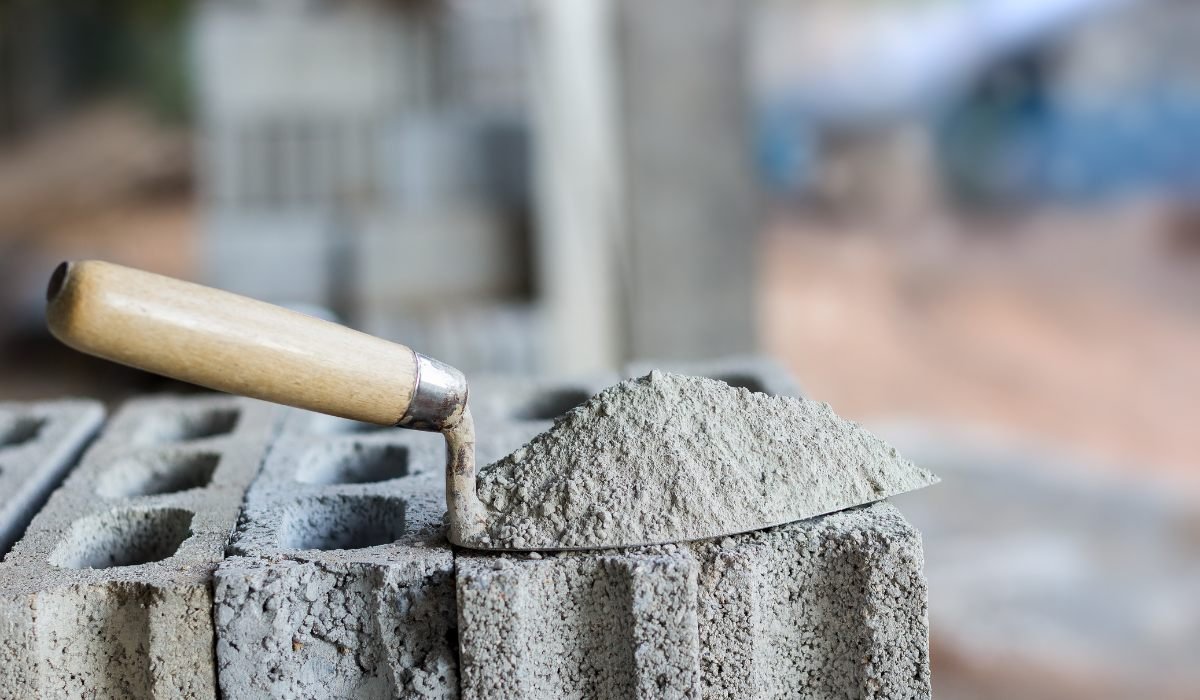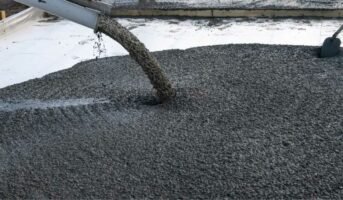A helpful tool for all your cement-related needs is the cement calculator. You may use it to calculate how much cement you’ll need while making mortar, concrete, or even simply cement and water. You may use it to calculate how much sand, gravel, and water to add to mortar and concrete mixtures.
In this article, you may first learn what cement is and how it varies from concrete. You’ll learn how to calculate it using bags or other volume units as well. As an added benefit, you will be able to determine how much sand and gravel you need for any concrete mix, as well as the texture and kinds of cement.
See also: Types of building materials
What is cement?
Cement, the binding substance utilised in construction and projects, is hence a sticky component. When coupled with water, these tiny powdered particles of this form of cement solidify. When cement compounds and water interact chemically, submicroscopic crystals or a gel-like material with a huge surface area are created.
It may also result in setting and hardening. Because of its ability to hydrate, hydraulic cement is frequently referred to as construction cement. Among these, Portland cement is the most important.
However, the history of hydraulic cement may be seen in ancient Rome and Greece. A hard solid was created over time by the reaction of lime and volcanic ash with water. This was employed as cement after then, more than 2,000 years ago in Roman mortars, concrete, and later constructions in Western Europe.
The phrase “natural cement” is used to describe materials that are similar to portland cement but are less heavily burnt and have an erratic composition. When he applied for a patent for a product manufactured from a synthetic mixture of limestone and clay in 1824, Joseph Aspdin of Leeds, Yorkshire, England, is credited with creating portland cement.
See also: Why is compaction factor test vital for construction?
What is concrete?
Concrete is a construction material with properties similar to rock that is made up of tightly bound particles. Due to its general characteristics, it is also frequently called “fake rock.” Concrete offers excellent compression resistance.
When it is necessary to tolerate tensile loads, reinforcement is inserted into the concrete to absorb tension. Concrete is one building material that we have access to. Furthermore, because it can be formed into a variety of shapes, it offers structural flexibility.
Because of this, concrete is relatively different from other building materials in terms of the ratio of components and the quantity of bags required to cover a certain area, which is often measured in cubic metres (feet, length, square and width are taken into account).
See also: All about fineness of cement
Concrete vs cement
Since they are frequently used interchangeably, many people believe cement and concrete to be the same thing. It is often used as a part of the concrete and not on its own. For instance, the slab foundation of your home is probably made of concrete, which was created using cement and other ingredients.
Even though it may be used alone, we also know it as a component of concrete. As a result, concrete is a widely utilised building material for sidewalks, backyard patios, bridges, dams, and roadways. Limestone, clay, and minerals high in calcium and silica are used to manufacture cement.
Cement, aggregate, and water must all be mixed together in order to create concrete. As a result, concrete is one of the most widely used building materials for both residential and commercial applications.
Its strength and longevity, which make it a practical and desirable building material, are also factors that contribute to its appeal.
Aluminium, iron, silicon, calcium, and other elements that are present in limestone, shells, chalk, clay, iron ore, and silica sand, among other things, can be combined to create cement, a binding substance. To create cement, a rock-like substance that is crushed into a very fine powder, these “ingredients” are burnt at an extremely high temperature.

Source: Pinterest
Cement calculator: How to calculate cement?
You may make the calculation with the aid of a cement calculator. Because cement is frequently used with other building materials like sand and gravel, we use a mix ratio to determine how much cement is needed. As a result, mix ratios help determine how much cement, sand, and gravel are needed and provide information about the strength and durability of the finished product.
The completed product will be more durable the more of it we incorporate. The conventional formula for determining an object’s volume and thickness is to multiply its width, length, and, in certain situations, depth and height. A very useful tool is this calculator.
Nowadays, we often utilise a 1:2:4 mix ratio while constructing reinforced concrete single-story homes. Due to this mixture’s 15 MPa compressive strength, it is sometimes referred to as M15 grade. However, if we were to build a two-story house, a stronger mix would be needed, such as the M20 grade mix with a 1:1.5:3 mix ratio.
It’s crucial to keep in mind that after water is added, the dry mix volume falls, lowering the volume when calculating the amount of cement in a mixture. The small cement particles, on the other hand, slip into the open spaces in the sand and gravel mixture when water is introduced to the dry mix.
Cement calculator: How much cement do you need?
Suppose we wish to utilise a steel mould we designed in our steel plate weight calculator to construct a concrete slab that is 20 cm x 20 cm x 5.0 MPa (725 psi) in size. Additionally, by multiplying the size of the concrete slab steel mould, we may determine the necessary wet volume of concrete.
Wet volume =20cm * 20cm * 20cm=0.2m *0.2m * 0.2m=0.008m3
It is significant to note that metres are typically referred to as cubic metres. Assume we want to use a dry-to-wet volume ratio of 1.54:1. The estimated dry volume may then be obtained by multiplying the calculated wet volume by 1.54.
Dry volume =Wet volume*1.54=0.008m3 *1.54=0.01232m3
For instance, we need a 1:5:10 mix ratio to construct a 5.0 MPa (725 psi) concrete block. Adding the individual components results in the ratio’s total components: 1 + 5 + 10 = 16. Sand makes up another five of these 16 components, while gravel makes up the remaining 10.
Volume of component= Volume of Cement / total number of parts
To start, we must ascertain the formula for determining cement volume, which is:
Volume of cement =0.01232m3 * 161 =0.00077m3
So, now that we are aware of the volume of cement, keep in mind the following formula to determine the volume of sand:
Volume of sand =0.01232m3 * 165=0.00385m3
Third, here is the formula for estimating gravel volume:
Volume of gravel =0.01232m3 *1610=0.00770m3
How to use a cement calculator?
Utilising the cement calculator is easy. Decide on the mixture you want to make first. Next, input the wet volume of the necessary mix. Although pre-filled, the dry-to-wet volume ratio may still be changed. The calculated dry volume will be displayed right away.
Thirdly, depending on the worker’s usual handling of the materials, you may specify the proportion of estimated trash you’ll need. After that, you will receive the entire dry volume.
Choose your preferred mix ratio before purchasing the required quantities of cement and sand for a mortar mix or cement, sand, and gravel for a concrete mix. The weight of cement is then automatically calculated using a cement density of 1440 kg/m3 (90 lb/ft3).
We have included cement in our cement calculator because it may be purchased in bags. Finally, input the weight of a bag of cement that is readily accessible in your area to calculate the number of bags required to fit the calculated weight of cement. When utilising our calculator, it will be easy for you to complete.
Cement calculator: Tips to remember
When calculating cement for your construction project, there are a few important tips to keep in mind to ensure accurate results:
- Always double-check your calculations: It’s important to re-check your calculations before placing an order or purchasing cement. Even a small mistake can have a significant impact on the amount of cement required for your project.
- Take into account wastage: Cement can be wasted due to spillage, improper mixing, or other factors. It’s important to include a wastage factor of around 2-5% when calculating the amount of cement needed.
- Consider the type of cement: Different types of cement have different densities, which can affect the amount required. Make sure to use the density of the specific type of cement you’ll be using when calculating.
- Calculate based on volume, not weight: Cement is typically sold by weight, but it’s important to calculate the required volume for your project. This will depend on the dimensions of the area to be covered and the thickness of the cement layer.
- Consult with a professional if needed: If you’re unsure about any aspect of your cement calculations, it’s always a good idea to consult with a professional or experienced contractor for guidance.
FAQs
How many cement bags do I need?
Volume is calculated using the formula length x width x thickness. As well as the height and feet, the length, breadth, and thickness may vary greatly. In order to determine how many bags of concrete you'll need, divide the total number of cubic yards required by the yield.
For a 10' by 10' slab, how much cement will I need?
You'll need 1.3 cubic yards for a 10’ by 10’ slab; we often add 10% additional to accommodate for any slab depth variations or spills.
| Got any questions or point of view on our article? We would love to hear from you. Write to our Editor-in-Chief Jhumur Ghosh at jhumur.ghosh1@housing.com |

Dhwani is a content management expert with over five years of professional experience. She has authored articles spanning diverse domains, including real estate, finance, business, health, taxation, education and more. Holding a Bachelor’s degree in Journalism and Mass Communication, Dhwani’s interests encompass reading and travelling. She is dedicated to staying updated on the latest real estate advancements in India.
Email: dhwani.meharchandani@housing.com












